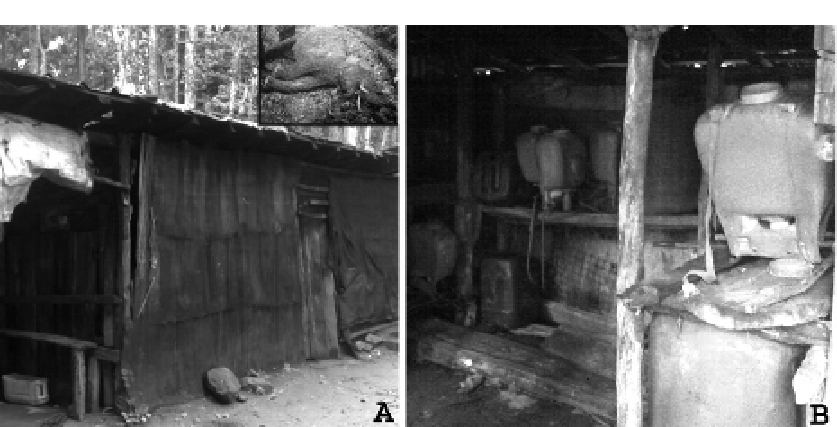Environmental Engineering Reference
In-Depth Information
Figure 4.4
Storage shed at tea estate that was raided by elephants
In another accident, carbofuran was responsible for the death of two elephants. The incident was
reported in a tea estate in Valparai, which is located in the Western Ghats. This area is well known
for its rich biodiversity (Report 2009b). Elephants in the region are in the habit of looting provi-
sion stores in search of salt and other grain (see Figure 4.4). In this case, a herd of seven elephants
destroyed a shack belonging to the tea estate and consumed vegetable matter and other leftovers
held inside. The shack was also used by workers on the tea estate to store fertilisers and equip-
ment for their application (as well as personal belongings and utensils used to prepare cups of tea).
Furadan granules were consumed by two elephants, which succumbed to poisoning. In this instance,
suspicion regarding Furadan was initially based on circumstantial evidence. The presence of carbo-
furan in the viscera of both elephants was subsequently confi rmed at The Regional Forensic Science
Laboratory at Coimbatore (Report 2009b). In our opinion, the Insecticide Rules of 1971 actually
provide suffi cient guidelines on the safe storage of pesticides to prevent such incidents, and hence
this accident should not have occurred.
Avian poisoning, due to ingestion of seeds treated with pesticides, is very common worldwide
(see also Chapters 7 and 8). For example, Pain, Gargi, Cunningham et al. (2004) described one such
incident, where 15 Sarus cranes (
Grus antigon
)
and three common cranes (
Grus grus
) were poisoned
by monocrotophos at Bharatpur reserve forest in India. Carbofuran granules have been extensively
used with seeds in India, and many birds could be regularly exposed, despite there not being any
reported incidences to date. Panda and Sahu (2009) have studied the effect of carbofuran on a domi-
nant crop fi eld earthworm (
Drawida willsi
) in a rice fi eld. They found that a single and double dose
application of carbofuran (1.1 and 2.2 grams per kilogram of active ingredient) resulted in a reduc-
tion of 17 and 23% in earthworm biomass, respectively. In this case, a secondary repercussion would
be that the prey base for birds would also be compromised.
4.9.2 Misuse of carbofuran
The second type of exposure, through carbofuran misuse, is a major cause for concern in India. Even
though the dosage which should be used for different crops and pests is clearly indicated in the leafl et
that accompanies the formulation, it is often the suppliers who advise farmers on the application rate.




























Search WWH ::

Custom Search